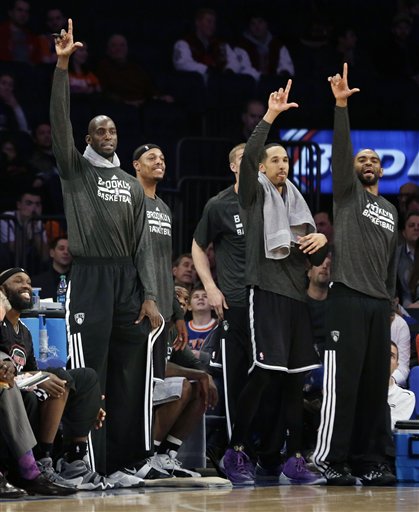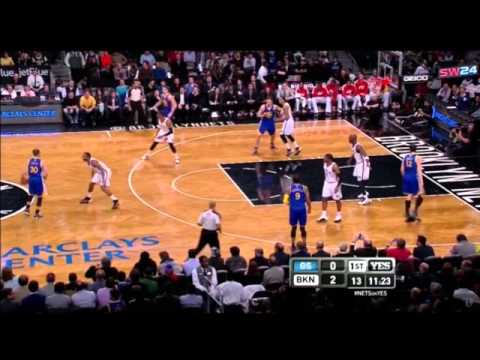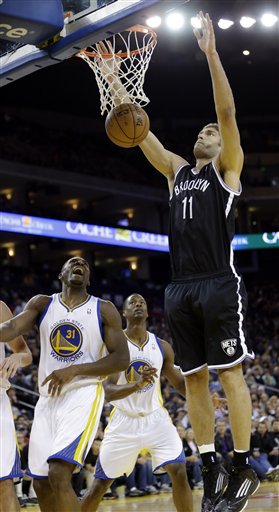
There’s nothing small about it.
The Brooklyn Nets have turned a corner in 2014: after a 10-21 start in 2013, they’ve rocketed out to an 8-1 start. It hasn’t come with a cupcake schedule, either. They’ve beaten the two-time defending NBA champion Miami Heat. They’ve beaten the Oklahoma City Thunder, the #2 seed in the Western Conference. They took down the Atlanta Hawks twice and the Golden State Warriors once. They beat the New York Knicks in Madison Square Garden after losing to them by 30 a month earlier.
Brook Lopez’s injury forced the Nets into those drastic changes. Kevin Garnett, who started the season as their power forward, moved to center. Paul Pierce, their small forward, moved to Garnett’s slot at power forward. Joe Johnson slid up to small forward from shooting guard. Either Alan Anderson or Shaun Livingston slid in next to Deron Williams, until Williams went down and both started.
Sure enough, they’re 6-0 when starting Livingston, Alan Anderson, Johnson, Pierce, and Garnett.
The change has made a staggering difference in Brooklyn’s on-court production. Their 8-1 record is tops in the NBA in the New Year. They’ve allowed a cool 100 points per 100 possessions, tied for the fourth-best defense in the NBA in that span, and they’ve got the fourth-best net margin in the league overall.
They’ve been lauded as a small lineup, but the secret is that they’re not that small: they’re smart, they’re long, and they’re disruptive.
When teams talk about small-ball, they often do it to speed up the game’s pace and get into a quicker offensive flow. Smaller players are normally quicker players, and having guys that can run the floor more effectively at your power positions can get you easy buckets in transition against bigger, slower teams.
Except that’s not what the Nets have done. Pierce isn’t faster than most power forwards, so that speed advantage doesn’t exist. Joe Johnson’s a shooting guard in name only: he’s big even for an average small forward.
The Nets haven’t picked up the pace, they’ve slowed it down: in 2014, they’re playing a tick over 90 possessions a game, down from 94.57 possessions per game heading into the New Year. They’ve scored less in the fast break, not more.
“We don’t look at it as a small lineup,” Kidd said after his team’s 101-90 victory over the Orlando Magic. “You have a 6’7″ point guard. Our two-guard (6’8″ Joe Johnson) is pretty tall. so we look at it the opposite way. Paul and Shaun have that ability to switch, and everyone’s helping one another.”
In Truth, Pierce is the only undersized player for his position. (I had to.) Plus, then they take him out, they replace him with Andrei Kirilenko, who’s 6’9″ with the wingspan of a small airplane.
It’s not smallball, it’s longball: they’ve masked Paul Pierce at the 4 with a group of agile, lengthy players, and it’s made a huge difference to the team’s offense and defense in 2014.
The Livingston effect
With or without Deron Williams in the starting lineup, Livingston has been a key cog for the team’s starting lineup in 2014. At 6’7″ with a wingspan nearing seven feet, Livingston has a wide advantage over his other point guard counterparts, and is long even for a shooting guard with Williams on the floor.
Livingston isn’t big enough to guard most forwards for long stretches, but his length allows him to switch onto them for spot possessions without losing significant effectiveness. “We like to switch aggressively,” Livingston noted Tuesday night after the team’s win over the Orlando Magic. “We don’t like to switch and just let teams be able to dictate what they do.”
Here’s one example:
“Paul and Shaun have that ability to switch, and everyone’s helping one another. – Jason Kidd
Watch the action between David Lee (#10 on the Warriors) and Klay Thompson (who starts in the opposite corner from the camera) at the top of the screen. Lee is guarded by Paul Pierce, the team’s nominal power forward, and Thompson is guarded by Livingston. But on a screen, the two seamlessly switch, leaving Lee in what’s normally an advantageous situation for a scoring seven-footer.
But Livingston fights Lee for position immediately, leaving him unable to post up near the basket. Once Lee does receive the ball and start to dribble, Livingston pokes the ball away, causing a turnover.
The Nets are 5.4 points per 100 possessions better defensively with Livingston on the court this season. “It doesn’t take as much energy as fighting over screens,” Livingston added. “I think that really helps us.”
Livingston’s length doesn’t just come into play on the defensive side of the ball. His length allows him to get easy shots off in the paint over his defenders. Even a well-guarded shot inside against him is a decent look: his release is so high off the ground that he’ll get a good look from within eight feet against nearly anyone.
The Nets have used Livingston sparingly in the post, but he’s exploited mismatches: he’s shot 52.2 percent on 23 post-up shot attempts this season, and his 1.10 points per possession in the post ranks eighth in the league, according to Synergy Sports.
He’s not just a long scorer, he’s also a crafty one, and the dual threat allows him to get off good looks in the post against any defender. Here’s an example against the Miami Heat on nickname night: the Nets clear out for Livingston, and he abuses his matchup — the 6’1″ Norris Cole — getting into the lane and spinning around him for an and-one layup.
Livingston’s size advantage also allows him to gobble up rebounds: he’s averaging 5.4 rebounds per 36 minutes in 2014, the highest on the team among its perimeter-oriented players.
The Big Ticket
The second major part of the longball lineup is the man in the middle, Kevin Garnett. Garnett played power forward for the majority of his minutes before Brook Lopez’s injury, but has slid into the center spot without issue.
“Ticket, he’s holding down the backline,” Livingston says of his starting center.
Garnett’s listed at 6’11”, but the joke around the league is that he’s 6’13”, thanks to his unnatural length and likely understated height.
His impact on the defensive end is almost too big for statistics to grasp, but let’s give it a shot: since January 1st, the Nets have allowed opponents to score 107.2 points per 100 possessions with Garnett off the floor, and 87.9 points per 100 possessions with him on the floor.
I fear stating the numbers doesn’t quantify how ridiculous they are, so let’s make some comparisons. Indiana’s league-best defense allows teams to score 92.8 points per 100 possessions. The Garnett-led Nets in 2014 are nearly a full five points better than that. Utah’s league-worst defense clocks in at around 107.6 points per 100 possessions, just a hair below the Garnett-benched Nets.
In sum: with Kevin Garnett on the floor, the Nets make the league’s best defense look average. With Garnett off the floor, the Nets look like the league’s worst defense. It’s that significant.
Garnett’s renowned around the league for his ability to play help defense and communicate, and that’s what he’s brought to the Nets. I’ve spoken about this at length already, but Garnett at center means he’s defending the paint more often, helping him defend against opposing drives much more frequently.
In 2014, the Nets allow 47.5 percent shooting on 17.8 attempts per 48 minutes in the restricted area with Garnett on the floor, and 58.7 percent shooting on 25.9 attempts per 48 minutes in the restricted area with him off. The difference is staggering.
Garnett’s positive impact hasn’t just affected the defensive side of the floor: he’s made a huge impact on the team’s offensive flow. Garnett is third on the team (behind Williams and Livingston) in passes per game, clocking it at around 38 passes per game despite playing around 22 minutes.
Most of Garnett’s passes come out of the high post. He’s a centralizer: standing in the middle to help the team swing the ball from side to side to find open looks. That stands in stark contrast to Lopez, who often received the ball as the final option.
The Nets have hit on something real with their new lineup. Even when Williams returns to the starters, he’s strong & long enough to have a similar effect as, say, Alan Anderson, while bringing his other creative abilities to the table.
But the Nets shouldn’t feel any need to get “bigger.” They’re already long enough.



















